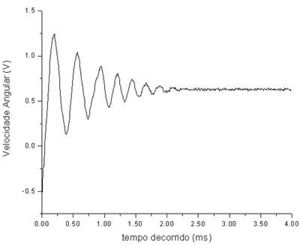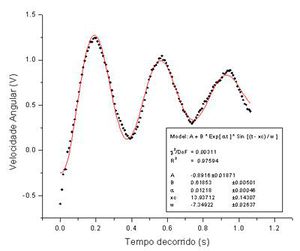Difference between revisions of "Damped Pendulum Oscillations"
(Texto inicial) |
|||
| (3 intermediate revisions by 2 users not shown) | |||
| Line 1: | Line 1: | ||
=Description of the Experiment= | =Description of the Experiment= | ||
| − | The purpose of this experiment is to determine the friction constant in a | + | The purpose of this experiment is to determine the friction constant in an harmonic oscillatory motion of a pendulum. Friction is generated by a variable electric charge in parallel with a hard disk motor placed on the shaft of the rigid pendulum acting as a generator. By varying this resistive load, the power consumed varies depending on the frequency of oscillation and its value. |
| + | <div class="toccolours mw-collapsible mw-collapsed" style="width:420px"> | ||
| + | '''Links''' | ||
| + | <div class="mw-collapsible-content"> | ||
| + | |||
| + | *Video rtsp://elabmc.ist.utl.pt/penduloamortecido.sdp | ||
| + | *Laboratory: Intermediate in [http://e-lab.ist.utl.pt e-lab.ist.utl.pt] | ||
| + | *Control room: Pendulo Amortecido | ||
| + | *Grade: ** | ||
| + | |||
| + | </div> | ||
| + | </div> | ||
=Experimental Apparatus= | =Experimental Apparatus= | ||
| Line 8: | Line 19: | ||
=Protocol= | =Protocol= | ||
| − | [[File:pamortecido-graph1.jpg|thumb| | + | [[File:pamortecido-graph1.jpg|thumb|Figure 1: Data without any active friction, maximum samples and maximum sample rate.]] |
| − | [[File:pamortecido-graph2.jpg|thumb| | + | [[File:pamortecido-graph2.jpg|thumb|Figure 2: Fitting of a damped sine to the three first periods. The friction constant is, in this case, \(0.0122 s^{-1} \).]] |
Under construction. | Under construction. | ||
| Line 16: | Line 27: | ||
=Advanced Protocol= | =Advanced Protocol= | ||
| − | The oscillation period decreases, even though the first three do not show this. Why? Find the mathematical expression that explains this behavior and fit it to the experimental data. Change the friction parameter and find the new friction constant. | + | The oscillation period decreases, even though the first three do not show this. (Why?) Find the mathematical expression that explains this behavior and fit it to the experimental data. Change the friction parameter and find the new friction constant. |
| + | |||
| + | |||
| + | =Links= | ||
| + | *[[Oscilações de um Pêndulo Amortecido | Portuguese version (Versão em Português)]] | ||
Latest revision as of 10:51, 7 May 2020
Contents
Description of the Experiment
The purpose of this experiment is to determine the friction constant in an harmonic oscillatory motion of a pendulum. Friction is generated by a variable electric charge in parallel with a hard disk motor placed on the shaft of the rigid pendulum acting as a generator. By varying this resistive load, the power consumed varies depending on the frequency of oscillation and its value.
Links
- Video rtsp://elabmc.ist.utl.pt/penduloamortecido.sdp
- Laboratory: Intermediate in e-lab.ist.utl.pt
- Control room: Pendulo Amortecido
- Grade: **
Experimental Apparatus
The pendulum is launched, and the user can choose the length of the rod and the initial angle. The pendulum's rod is attached to the head of a salvaged hard-drive. This allows a measuring of the pendulum's angular velocity, as a function of time.
Protocol
Under construction.
Advanced Protocol
The oscillation period decreases, even though the first three do not show this. (Why?) Find the mathematical expression that explains this behavior and fit it to the experimental data. Change the friction parameter and find the new friction constant.

